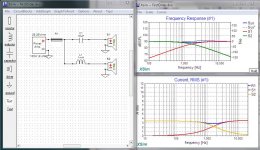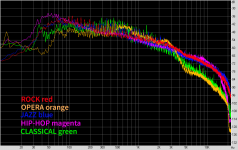Why is it that we have to assume the whole 100W of power is being delivered to every branch of the circuit (tw, mid, bass)? Ok, it is obviously not a good practice to achieve a 2ohm impedance at 2kHz but we can remedy it, likely.
You need to understand Ohm's law and how an amplfier works...
First Ohm's law tells us that Current is the result of applying Voltage across an Impedance (or resistance) ... Current == Voltage / Resistance... I==E/R
Watts Equations tell us that power is the result of Voltage and Current ... Power == Volts X Amps ... P == E x I. Thus, each time we apply a Voltage across a Load, we are dissipating Power.
An amplifier does not create current and voltage separately. Just like in Ohm's law it creates a voltage across the load. The current that flows is a result of that voltage and the impedance of the load... within the limits of the amplifier's ability to deliver current. Power does not happen without producing some heat... too much current will overheat an amplifier and could kill it.
The assumption is not that all the power has to go through each driver. The necessary caution is that no part in a crossover draws enough current to kill the amplifier that's feeding it.
The matter of trying to get all the current flowing through the drivers, addresses the efficiency of the crossover. If literally all of the amplifier's current goes through drivers (rather than being shunted off to ground) we actually have a crossover that is 100% efficient. If we are wasting half of the amplifier's current in shunt parts that falls to 50% ... and some crossovers are worse than that.
Below is a simple 1st order crossover ... a coil and a cap ... take a look at the current graph... Note that literally all of the power being taken from the amplifier is going through the drivers ... Despite it's other failings, this circuit is 100% efficient. Now take on the tweeter circuit and add a .1mh choke to ground behind the capacitor... see the effect? Current is being routed through the coil, reducing the crossover's efficiency and causing more heat in the amplifier.
When I design from scratch, I always start with first order and add parts reluctantly, to keep the circuit as efficient as possible, to protect the amplifier.
Attachments
Last edited:
You may also want to take a look at THIS THREAD which was started to discuss crossover efficiency, XSim tricks and general theory...
Douglas, thanks for answering my earlier question.
Spectrum of Musical Genres
At first glance when part of the spectrum is at full output, 2.5kHz is going to be drawing maybe a tenth of the current that XSim is showing.
AllenB said:Doesn't XSim consider frequency by frequency receiving the whole amplifier output, something that would not happen in practice especially at higher frequencies?
I wanted to put some numbers to this effect. According to this study, the music spectrum tends to fall at approximately -6dB/octave.Douglas Blake said:Yes it does... and it should.
It merely runs a spice analysis of your design, just like LTSpice would with the right part models.
It's not the software's job to protect us from ourselves.
Spectrum of Musical Genres
At first glance when part of the spectrum is at full output, 2.5kHz is going to be drawing maybe a tenth of the current that XSim is showing.
Attachments
At first glance when part of the spectrum is at full output, 2.5kHz is going to be drawing maybe a tenth of the current that XSim is showing.
Sure thing... well known... but now ask yourself how many amplifiers, drivers and power supplies are designed with this in mind, too.
It's not a reason (read: "excuse") to get sloppy in your designs and certainly not something you can count on.

